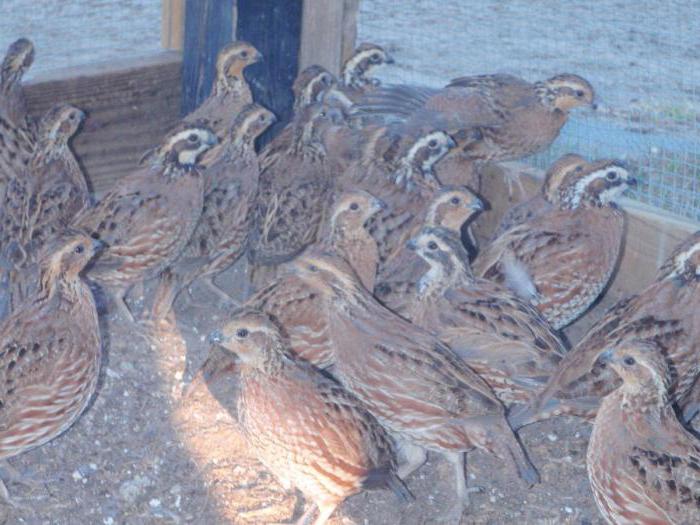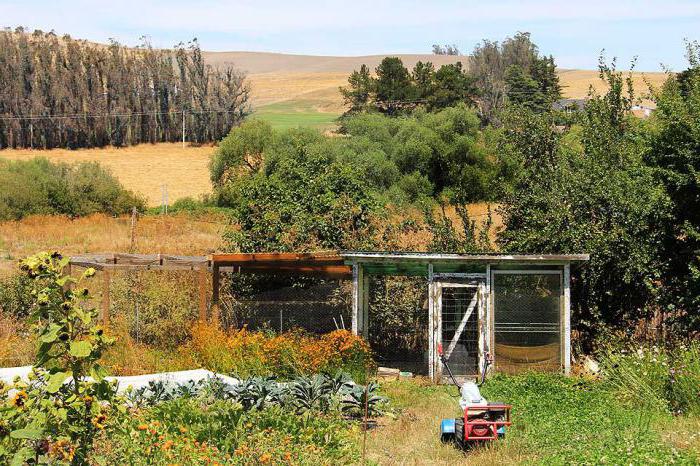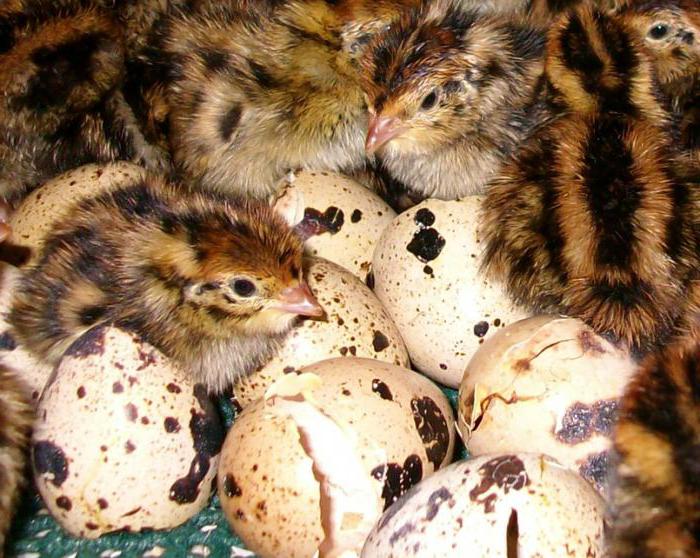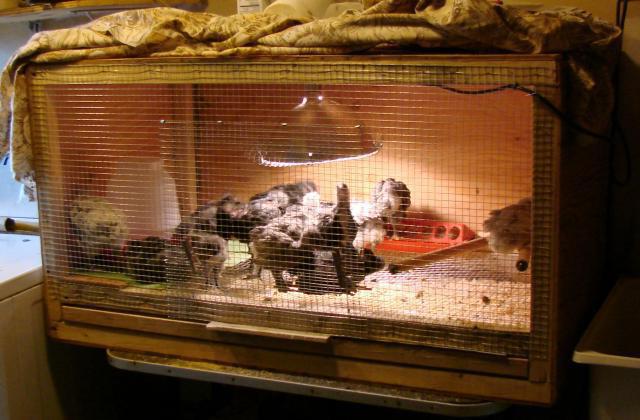“Small, but daring” - this can rightfully be said of quails. Small birds are very profitable to breed, including in the country or even on the balcony. Their meat and eggs are an excellent alternative to chicken products, while quails need much less space and feed.
Benefits of Quail Breeding
Quail meat is considered dietary, it is rich in B vitamins, contains iron, potassium, copper, beneficial amino acids.
The advantage of this meat is that it does not lose its beneficial properties during freezing, which means that it can be stored for a long time. It is recommended for diseases of the gastrointestinal tract, diseases of the heart and blood vessels, anemia, diabetes mellitus, asthma, tuberculosis.
The conditions for keeping quail at home do not reflect on the beneficial properties of quail eggs, only their number can change, as well as the amount of pure meat of this bird.
Eggs are healthy and nutritious; they contain many times more nutrients: iron, potassium, cobalt, copper, phosphorus and B vitamins than chicken. Not only that, quail does not get sick and does not tolerate salmonellosis, so their eggs can be eaten without heat treatment, preserving all the beneficial substances.
Quail conditions
At home, quails are not so difficult to keep. It is important to observe two main conditions:
- necessary temperature conditions;
- special cage.
For quail, the ambient temperature is very important. At low temperatures below 5 ° C, the bird dies, at 25 ° C and above it will begin to drop plumage. At high temperatures and their sharp jumps, quail noticeably reduces productivity.
To increase egg production, you can artificially increase daylight hours, but quail, like other living things, become aggressive when the time for rest is reduced. The aggression of the birds will have to be pacified either by fencing off a separate corner for them in the cage, or by darkening it for a while.
Today, breeding of miniature birds is not uncommon, many people know what quail is. Home maintenance is possible in good special cages for them, and buying such a cage is not a problem.
If there is a desire and opportunities, the cell can be made with your own hands, observing certain requirements.
Quail can not tolerate salmonellosis, but this does not mean that they have no parasites at all. To save the bird from pollution, once a week (it is especially important to observe this condition during molting), a small deep trough or a box with a mixture of wood ash and sand, in which they bathe, is placed in a cage.
The content of quail at home in winter is, first of all, maintaining the temperature regime. The temperature in the room where the quail is located should not fall below 16-17 ° C, otherwise the egg production of the bird drops sharply. At the same time, there should be good ventilation without drafts, since the birds in the stuffy cages get sick, and the humidity is about 65%. To maintain humidity at this level, you need to spray water from the spray gun or water the floor with it.
Using the norms of minimum air exchange in the room, it is possible to calculate what ventilation should be provided if 1 kg of live weight of quail requires 1.5 cubic meters of air exchange per hour in winter and 5 cubic meters in summer.
Quail Cage
There are some conditions that a “home” must satisfy in order for quail content to be successful at home.Cages with a height of not more than 0.2 m in area are made at the rate of 10 adult birds per 0.2 square meters of floor. Oddly enough, excessive open space leads to a decrease in egg laying quail, and height - to the fact that jumping crumbs can break their heads, knocking on the ceiling.
The fencing should be made of metal rods and a galvanized wire mesh so that in the front wall the quail can poke its head through it, getting to the feed and water in the feeder and drinking trough outside the cage.

The cage should be equipped with two trays. One is for eggs that simply roll into it, as quails are carried directly to the floor. The second is for litter, otherwise the eggs become contaminated and there is a risk of infectious diseases.
The floor in the cage should be covered with a replaceable litter. It can be straw, hay, ordinary sawdust or shavings.
Quails can also be kept in cages, which also need to be covered with a net on top. These are close to natural conditions for keeping quail at home. The photo of birds in the aviary resembles shots of wildlife.
Buying quail
Adult quails need to be acquired at the age of a month and a half. This is the age at which a female, having reached puberty, begins to actively lay eggs. The season does not play a role for these birds, since the weather conditions for them still need to be created artificially.
Buying poultry is best at specialized farms, where there is a professional approach to poultry farming.
Before buying quails, you need to carefully examine them. Feathers under the tail, beak and paws should be dry and clean. The sick bird is listless and disheveled, breathing with wheezing and whistling.
The conditions for keeping quail at home usually differ quite sharply from those in which they grew on farms or at breeders, so at least habitual feed should remain in the first month after the change of residence of miniature birds. Otherwise, not only egg production may decrease, but also a quail indigestion. Later, they can be gradually transferred to another feed ration.
If it is not supposed to breed quail, and you need a bird only for fattening and for the sake of eggs, then it is not necessary to buy a male, the females will continue to run without it.
Quail Breed Selection
Like any other representatives of poultry, quail are divided according to purpose into four groups. They can be meat or egg, meat-and-egg, decorative quail is also grown. Breeding and keeping at home poultry of egg and meat-and-egg direction gives about the same amount of meat and eggs. The difference between them begins to be felt when breeding on an industrial scale, when the livestock numbers tens of thousands of individuals. But the meat direction in its pure form gives a meat yield of 100-150 g per bird more. For example, if you keep fifty quails, the difference is 5 kg.
The choice of breed does not have a particular effect on the conditions of keeping quail at home.
First of all, the Japanese quail belongs to the egg direction, the female of which gives about 300 eggs a year. The average weight of one egg is about 12 g with a female weight of 130-150 g. Marble quails, which are a mutant breed of the Japanese, have approximately the same indicators.
The quail of the Estonian kaitavers breed surpasses the Japanese counterparts in mass, not inferior to them in egg production. Females weigh up to 210 g and give 310 eggs per year.
The following can be called black and white English quail, the females of which, with a body weight of up to 200 g, give 280 eggs per year.
The only quail meat breed bred by the Americans is Pharaoh. The weight of quail females of this breed sometimes exceeds 300 g, they give about 200 eggs a year, however, their weight is about 18 g.
If you intend to use meat and eggs for yourself, keeping quail at home, reviews unanimously call Pharaoh exactly as the best breed for this purpose, since its only drawback is the peculiar, to say the least, plumage color, which negatively affects the presentation plucked carcasses.
Hatchery poultry
Unfortunately, domestic quail does not sit on an egg, therefore this bird is bred only in incubators. If the task is to gradually expand production, and not just get meat and eggs for your own consumption, then it is much more profitable not to buy a grown bird, but to raise chickens in an incubator, buying eggs for the first time in the same specialized farms.
To fully comply with the conditions for keeping quail at home, incubation of quail eggs can be performed in any standard small-sized incubator. It will be better if the incubator is equipped with a device for automatic or semi-automatic egg turning.
The usual device for seven dozen chicken eggs is even more convenient to use for breeding quails. Lined with cotton or soft cloth around the edges, small quail eggs do not roll around the incubator, and they do not need to be constantly shifted from the edges to the center, where the temperature is slightly higher, since they are all located there.
You need to buy fresh eggs, not older than a week, preferably one size. The incubation process of quail eggs is 16-17 days. Turn the eggs at least three times a day, and preferably six.
Need to strictly withstand temperature condition checking the temperature with a medical thermometer, since high measurement accuracy is needed.
The first 10 days, the air temperature in the incubator should be 38.5 ° C, then it must be reduced to 38.0 ° C. The day before the withdrawal and during the withdrawal, the quail will be kept at 37.5 ° C. Humidity should be maintained at 65-75%. For this, special containers with water are provided in the incubators, which must be covered with a grid with small cells so that the tiny hatched chicks do not fall into them. Quails are removed in a maximum of 12 hours and are quite friendly.  Experienced farmers say that chicks hatched later should not be looked after, they will die sooner or later, only taking away time and nerves.
Experienced farmers say that chicks hatched later should not be looked after, they will die sooner or later, only taking away time and nerves.
Growing quail
Conditions for keeping quail at home provide for compliance with temperature and light conditions. This is especially important for chicks.
In the first few days of life, the quail is kept at a temperature of 33-35 ° С, which should be gradually reduced to 25 ° С during the month in order to prepare the chicks for release.
The first two weeks of the quail must be kept around the clock during the day, then the daylight hours are reduced to 17 hours and no less, since the light affects the egg production of the bird in the future.
In addition, newly hatched chicks weigh no more than 8 g and can hide in any crevice or become prey for larger domestic animals.
Therefore, for growing young animals you need to have a brooder that is easy to make from plywood and mesh, or to adapt for this purpose any box of cardboard, plywood or wood. The top of the box must be covered with a soft mesh.
The box looks more preferable option only at first glance. Yes, for the cultivation of a small amount of young growth, the costs of only acquiring and installing electrical wiring are more profitable. But in this case, the maintenance of the chicks will require close attention. In addition, constant intervention leads to serious stress in babies and even the death of some of them.
Mesh bottom and litter tray cannot be installed in an unadapted box. If you cover the bottom with paper, the legs are spread on it.Litter from sawdust is also not good - chicks can peck it, and you have to change any litter often, hence the stresses. The constant replenishment of the feeder and drinking bowls inside the box also leads to them. And this is if you do not take into account that in an open drinking bowl the quails are splashing in pleasure, mixing food and litter in the same place, and they turn the home-made vacuum almost immediately.
These are the nuances that distinguish the conditions for keeping quail at home. That is why growing chicks is best done in a professional brooder, even made with your own hands. And its maintenance takes much less time, and the young growth in it feels much better.
Whatever the design of the brooder, it still needs to be heated and lit.
If the care and maintenance of quail at home (young animals) is limited to one brooder, then you can use one infrared lamp with a dimmer to regulate the lighting for both lighting and heating. Enough of its power up to 500 kW.
When massively growing quails from 500 heads, it is more efficient to use heating elements of the “warm floor” system with a manual temperature controller for heating, and the lighting system with a low-power dimmer is mounted separately.
Feeding troughs and drinking bowls can also be improved so as not to disturb the kids once again.
A hose with a water tank at its opposite end must be brought to the drinker, and a sufficiently wide corrugated tube through which to feed the food from the outside to the feeder.
Since the purposes for which quails are raised differ, breeding and keeping at home males and females can also be different. You can separate them at the age of three weeks. By the color of the plumage on the neck and breast, you can determine the gender of this bird: in males it is darker, and the black specks are smaller.
If breeding is not supposed, that is, fertilization of eggs, then rejected females and all males are transferred to a separate cage for fattening.
Feeding quail
The diet of quail young is no different from feeding chickens.
Feeders vary in low margins, and only drinkers should be used with vacuum so that the quail is not drowned in them.
The first food for the newly hatched quail is a chopped hard-boiled egg. At the same time, babies need to be given a solution of levomycetin or potassium permanganate for the prevention of diseases.
Three days later, you can add cottage cheese to the diet, and for quick weight gain - corn grits. However, you can feed the quail young growth with a special feed, which is intended for newborn chickens, adding chopped greens to it by the end of the first week. Eight days after birth, the quail is transferred completely to the purchased compound feed for chickens, and two weeks later - to food for an adult bird.
Feeding Adult Quail
Keeping and feeding quails at home is easier and more profitable than chickens.
In general, the egg mass and the amount of feed eaten are the same for one chicken and four quails, but forty quails take up significantly less space than a dozen laying hens, and it’s easier to feed them, factory-fed compound feeds balanced in terms of vitamin and mineral composition and protein.
Adult quail needs to be fed three times a day at the same time, the daily feed rate is 25-30 g. The bird eats its one-time serving in about half an hour. Deviations from the norm in any direction negatively affect egg production.
Because one of the most unpretentious poultry in food is quail, keeping at home is facilitated by the fact that any kind of grain feed, crushed grain, nettle, dandelion, cucumber grass, and yarrow are herbal supplements. In winter, there are no problems with vegetable feed either.Quail gladly eat green onions, sprouted grains, crushed corn, sunflower seeds, peeling any vegetables from beets and pumpkins to cabbage, boiled potatoes or vermicelli. Fish flour is useful for birds, for lack of it it is possible to mix raw or boiled fish, ground in a meat grinder, and sometimes fish oil, a couple of times a week in feed. Naturally, mineral supplements must be introduced into the diet: lime, chalk, eggshell.
In a separate feeder, periodically pour coarse sand or small pebbles.
No matter how domesticated the quail, they are still birds, albeit small, and they are happy to eat small bugs, which are abyss, slugs and snails in the summer at any dacha.
Quail can not be given nightshade, neither greens, nor berries, parsley, celery, sorrel, buckwheat, potato tops. But this ban is unlikely to greatly complicate the conditions for keeping quail at home.
Fattening quail
For fattening, females and males are kept in separate cages at the rate of 8.5 cm2 per individual and preferably in another room, the air temperature in which is about 20-24 ° C. To reduce the egg production of females and the activity of both, keep them in a shaded place without intense lighting.
They feed the bird four times a day: twice with corn and greens with feed fats, and twice more with grain waste.
Quail is usually fed no more than 2 months. The mass of quail ready for slaughter is from 120 g. Females who have ended the period of active egg laying at about the age of one year are also slaughtered.
For six hours before slaughter, the bird is not fed, but only in unlimited quantities give water.
The slaughter area must be specially equipped. The quail is cut off with a hatchet or a large knife, the blood is drained, the legs and wing tips are cut to the first joint with scissors on the shin, plucked and gutted the carcass. The whole procedure, in the presence of some skills, takes no more than a minute or two.
“For a long time, the fairy tale affects, but not for long the thing is done” - the conditions for keeping quail at home are not so complicated. Temperature, lighting, feeding, cleanliness and a little attention and time - as a result, fresh dietary quail eggs and tender meat appear on the table.








